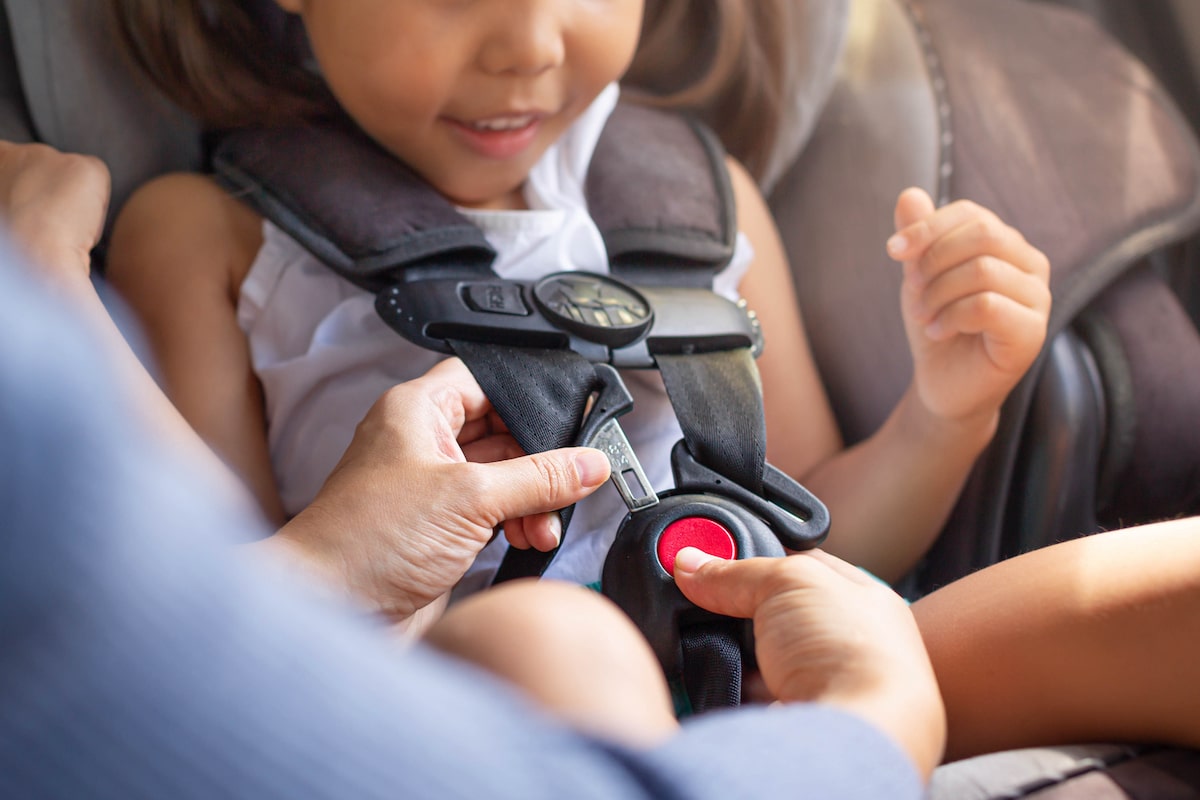I remember vividly the day I watched my nephew for the first time, and I had to take him to a doctor’s appointment.
The car seat was already installed in my car, I sat him in the seat and buckled him in. I didn’t tighten the straps, and I didn’t make sure that the seat was correctly installed. There was no way I had him installed correctly.
Looking back at this, now that I am a mom, I am ashamed. What if my negligence had caused my nephew to get hurt or killed? I can’t believe that I had allowed myself to be so complacent with his safety.
When I was about 20 weeks pregnant, I started researching baby items to put on my registry. Having a safe, well-trusted car seat was very important to me.
Eventually I settled on Britax (Boulevard 65 CS) because of their stellar reputation for safety, ease of use and because I could use this particular seat from birth until 65 pounds.
I read a great deal about installation and use, but I neglected to actually have my car seat installed by a professional.
I mean really, how hard can it be? The truth is, unless you have had your car seat installed by a NHSTA or Car Seat Tech, there is a pretty good chance you are using it incorrectly.
When you really think about it, many of us will spend around $200 to $300 on a car seat, but we scoff at the idea of spending an extra $50 or so to have it installed properly.
Recently I had the installation checked as part of a fundraising event for my local La Leche League. Out of the approximately 20 seats checked, only my car seat was installed and being used correctly.
Unfortunately, that isn’t surprising. Statistically speaking, upwards of 70 to 90% of car seats are not being used properly in Canada and the United States.
The fact that so many people are using and installing their car seats incorrectly is sad. A leading cause of child fatality and injury every year in both the United States and Canada is car accidents.
Knowing that such a significant portion of our population is using and installing our children’s car and booster seats incorrectly, I am left to wonder how many of these injuries and deaths could have been prevented with their proper use.
While this information is not meant to scare or to demean anyone, I hope it will encourage parents and caregivers to take a second look at their car and booster seats and how they are installed.
It is not shameful to ask for help from a professional, and it doesn’t make you a bad parent if you are proactive in changing when you realize something is wrong.
No one is exempt from making mistakes, but when you know better, you can do better.
Because I am a U.S. citizen living in Canada, I want to touch both on American and Canadian guidelines for car seat safety as well as some general car seat safety information.
Using Your Car Seat
Whenever I see a photo online of a child in a car seat, my first reaction is to check whether or not they are strapped in properly. These are mistakes that I most often see:
- The straps are too loose or twisted.
- The chest clip is too low.
- The child is wearing bulky clothing, a winter coat or a bulky blanket.
In order to fix these things you need to address the following:
- When you are strapping your child in, they should be wearing nothing heavier than a light fleece. I know for some people this is troublesome. I live in Canada, I get it. It gets cold in the winter. There are several ways to alleviate the situation. You can get polar fleece jackets, a car seat poncho, and if you are using an infant carrier you can use a shower cap style bunting cover (this only covers the top of the car seat, acting like a blanket, and does not go behind the child).
- You need to be sure that the harness straps have originated in the correct spot. If your child is forward facing, the harness straps should sit at or above shoulder height. If the car sear is rear facing, the harness straps should be at or below shoulder height.
- The chest clip needs to be at the chest. The top of the chest clip should be at armpit level.
- Make sure that the straps are not twisted and are tight enough. You shouldn’t be able to pinch the strap with your thumb and forefinger, and no more than one finger should be able to fit between your baby and her straps. While it may seem a bit redundant, you will need to tighten your child into her car seat every single time, even if you don’t loosen the straps to take her out of the seat.
Installing Your Car Seat
Some common mistakes I have seen when installing the car seat into your vehicle are:
- Borrowing LATCH/UAS clips for a car seat installed in the center of your vehicle
- Using both the LATCH/UAS and the seat belt to install
- Forward facing too early
- Angle of installation is wrong
- Car seat not installed tightly enough
- Using products that were not designed to be used with your car seat (aftermarket products)
- Position of handle when using an infant car seat
LATCH is an acronym for Lower Anchors and Tethers for Children, it is known as UAS or Universal Anchorage System in Canada. LATCH/UAS is mandatory in all vehicles manufactured after 2002 in at least two rear seat positions.
This means that if you wanted to, you should theoretically be able to install two car seats using LATCH. The benefit to using LATCH/UAS is that it is generally easier and quicker to install.
LATCH/UAS is normally located directly behind the driver and passenger seats. If you have a car seat installed in the center seat and there is no LATCH specifically for the center seat, you CANNOT borrow a LATCH/UAS clip from either side of the center seat.
There are very few car seat manufacturers that allow this, and you need to refer to your car owners manual to make sure that your car will allow it. If your car manual does not explicitly say that you can borrow LATCH/UAS clips, then don’t do it.
Additionally, installing your car seat with both the LATCH/UAS and a seat belt is also prohibited.
Car seat safety is not tested when both forms of installation used together, so there is no telling what could happen in the event of a crash. Choose one or the other. You should choose whichever one allows for the most secure installation.
But if your child will be forward facing using the LATCH/UAS installation, there are a few things to consider.
In Canada, the rule currently in place is that if your child is 40 pounds or more, you need to contact your car manufacturer to see if they allow your child to have his car seat installed using UAS.
In the United States, starting February 2014, a new law has passed stating that any child who weighs between 32 and 40 or more pounds (a combined weight total of 65 pounds between child and car seat) will need to have his car seat installed using a seat belt.
There is a significant amount of confusion about what this actually means and how it will impact car seat installations in the future. Car seat installation technicians will be the best source of information, because they have access to the LATCH manuals.
The Rear-Facing/Forward-Facing Debate
Among other things, a big debate in the mama community focuses around forward facing and rear facing your car seat.
The law in the United States says that your child will minimally need to be over a year old and weigh at least 20 pounds. In Canada, your child will need to weigh at least 22 pounds and be able to walk unassisted and be over a year old.
It is important to note that these are minimums and that your child will need to reach ALL of these minimums, not just one, before you should install his car seat forward facing.
I have seen many babies flipped to forward facing before they were a year old. In fact I have even seen someone have their infant bucket seat installed forward facing (I didn’t even know that was possible).
The Canadian Pediatric Society, The American Academy of Pediatrics, and even your car seat manual will tell you that it is safest for your child to remain rear facing as long as possible, ideally until at least the age of two or until he reaches the weight or height restrictions for rear facing in his car seat.
Additionally, if you live in Canada and your child is forward facing in his car seat, you must also use the top tether when installing. In the United States, you should also be using the top tether for installation, but because of the new law coming out in 2014 that I mentioned above, there is debate as to whether or not you will still be allowed to use the top tether (the T in LATCH) if your child and your car seat weigh 65 or more pounds combined.
If your car was manufactured prior to 2002 and doesn’t have LATCH/UAS, you will need to have a tether bolt installed in your vehicle.
When you install your car seat, having the correct angle of installation, and having it in tightly enough often go hand in hand.
When your seat is installed rear facing, it needs to be at a 45 degree angle to the ground. You will often need to put a significant amount of weight on the seat so it is secure enough and does not move more than one inch in any direction at the belt path.
Your seat, if applicable, will also need to be maximally reclined. In order to achieve both the proper angle and a tight fit, you may need to use a pool noodle or a towel under the front of your seat.
Many car seats will have an indicator to let you know whether or not you have installed the seat at the proper angle, but be sure that you are on a level surface.
Aftermarket Products
Any aftermarket product that has not been tested by and/or produced by the manufacturer for your car seat specifically, is generally not considered safe.
For example, products like the JJ Cole Bundle Me are not considered safe in car seats. Anything that is placed between your baby and his car seat can cause strap routing and compression issues.
I have seen this first hand. One of my husband’s friends had his daughter in an infant bucket seat, and I mentioned to him that the straps were not in the correct position.
The strap origin for rear facing car seats should be at or just below shoulder height, but because of the JJ Cole Bundle Me, the harness strap was almost an inch above her shoulder!
With all things, check your car seat manual. If it says to not use third party aftermarket products like harness strap covers, add-on trays, head huggers, padded car seat bags and mobiles, then don’t use them.
If you have any questions, you can always contact your car seat manufacturer directly.
Infant seats have another factor that can impact safety —their carrying handle. Many people believe that all handles need to be down when installed in a car.
This is a myth. You should do as your car seat manual tells you. If it says to keep the handle in a upright and locked position during use in a vehicle, then that is what you should do.
There is no one rule on this, follow what your car seat manufacturer says.
Car Seat Safety: Outside of the Car:
Car seat safety isn’t just for the car. With the portability of infant bucket seats, new dangers have arisen. Car seats are meant to be used in cars.
They are not meant to be used as a temporary crib or as an attachment to a shopping cart. Almost all car seat manuals explicitly say that you should NOT place an infant car seat on top of a shopping cart. It is simply not safe.
There are several ways to avoid lugging your 20lb+ car seat into the store. You could:
- Wear your baby
- Bring a friend or family member along for an extra set of hands
- If you need to bring in the car seat it should be placed inside of the basket. This will obviously limit the amount of items you can buy (and you should never put items in the basket with your baby.)
There are hundreds of car seats on the market with many variables that will affect the safety of the installation of your chosen seat in your vehicle.
It can be daunting and confusing for even the most savvy of individuals. I highly recommend researching car seat installation technicians local to you.
In the United States go to this link and search for a location near you. In Canada you go to this link and search by province.
It is always prudent to read the manuals for both your car and your car seat, and be prepared to do the installation yourself with help and guidance from the technician.
This information is not intended to replace the information given in both your car seat AND your car manuals or that of a professional. I am just one mama who likes to read (a lot) about all things baby!
Featured Image Credit: Shutterstock
Tim Thomas is a renowned writer and entrepreneur specializing in finance, investing, and money matters. With his extensive knowledge and experience in the financial sector, Tim offers valuable insights into the world of personal finance, stock market trends, and investment strategies.





